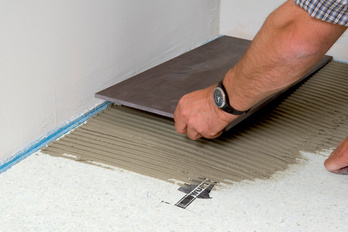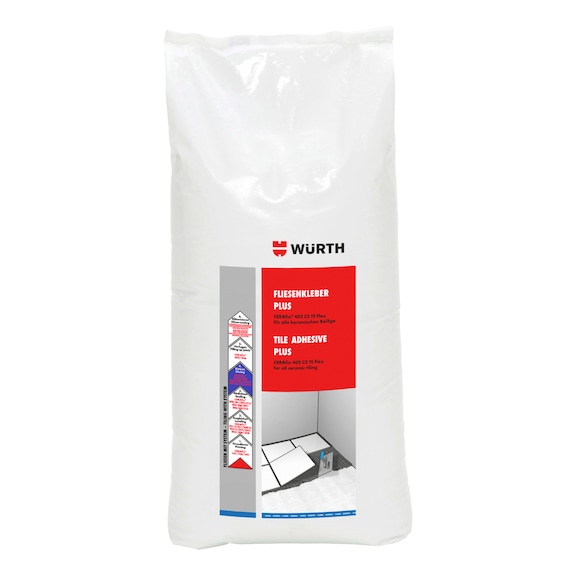For detailed information, other images and documents, please select individual articles from the following table.
Tile adhesive PLUS CERAfix® 402 C2 TE Flex For all ceramic floor coverings in accordance with EN12004, C2 TE
Flexible thin- and medium-bed mortar in watertight film bag
Register now and access more than 125,000 products




Variants
High degree of flexibility
- Secure on surfaces subject to considerable movement
- Suitable for bonding stoneware
Very versatile
Suitable for thin bed and medium bed mortars
Quality tested in accordance with Euro standard
- Fulfils and exceeds class C2 in accordance with EN 12004
- Monitored formula
Excellent stability and high degree of initial adhesion
- Prevents wall tiles from slipping
- Heavy and large tiles can be securely bonded
Long adhesive drying and processing times
- Corrections can be made long after tiles are laid
Smooth and easy application
- Minimal force required when fitting
- Higher daily output
Resistant to thawing/freezing alternations
- Suitable for indoor and outdoor use
- Can be used in wet rooms and swimming pools exposed to high stresses
Suitable for underfloor heating
Our products featuring the EMICODE label are low emission/environmentally compatible. The EMICODE classification system awards labels to construction products that comply with the very stringent health and environmental requirements of recognised institutes.
Tested in accordance with EN 12004 C1
- Fire behaviour: A1fl/A1
- Adhesive tensile strength after dry storage: ≥ 1 N/mm²
- Adhesive tensile strength after immersion in water: ≥ 1 N/mm²
- Adhesive tensile strength after warm storage: ≥ 1 N/mm²
- Adhesive tensile strength after alternating freezing/thawing stress: ≥ 1 N/mm²
EMICODE EC1plus: Very low emissions: The EMICODE classification system distinguishes the environmental and health compatibility of construction products. The lowest-emission products bear the EC1plus mark.
When laying tiles and panels outdoors (e.g. balconies and terraces), the CERAfix 315 system balcony film should be used in conjunction with CERAfix 402 Plus! CERAfix 420 can be mixed in to increase flexibility/deflection.
During installation, the product-specific properties of the covering materials (tendency to discolour, curling etc.) and the installation recommendations of the tile and panel manufacturers must be observed. We recommend carrying out a trial adhesion if necessary!
Thin-bed mortar that has begun to harden must not be made workable again by adding water or fresh mortar!
When laying large tiles (from 30 x 60 cm), mortar should be applied to the backs of tiles in a scratch coat or using the buttering/floating method to improve adhesion.
Contact between the cement-based tile mortar and the magnesite screed leads to destruction of the magnesite screed by chemical reaction. Backwards moisture load from the substrate must be prevented using appropriate means. Magnesite substrates must be mechanically roughened and primed with CERAfix 103 epoxy resin. Spread plenty of fresh TEGAfix 430 quartz sand over the fresh epoxy resin layer. After the specified waiting time of approx. 12-16 hours, perform laying work.
CERAfix 402 Plus is a hydraulically curing mortar that must be protected against the effects of water and frost until fully cured, which could take several days in unfavourable weather conditions. Protect against exposure to water and frost during this time!
When laying tiles on calcium sulphate-bonded substrates, the primer/mortar combinations in accordance with DIN 18157-1 or ZDB information sheet must be observed.
Take suitable measures to prevent mortar from solidifying in the wall-floor connection!
Currently applicable regulations and the relevant standards must be observed! For example: DIN 18157; DIN 18352; DIN 18560; DIN 18 202; DIN 1055
ZDB information sheets, published by the Fachverband des deutschen Baugewerbes (German Construction Industry Association).
BEB information sheets, published by Bundesverband Estrich und Belag e. V. (Federal Association for Screeds and Coverings)
Technical information "Interface coordination for heated floor structures".
Observe the valid safety data sheet, GISCODE: ZP1

| Suitable for grouting* | after approx. 12 hours |
| Can be walked on* | after approx. 12 hours |
| Can be fully loaded* | after approx. 7 days |
| Test | Classified as C2 TE in accordance with DIN EN 12004, BAUTEST Dresden test certificate |
| Report on the classification of fire behaviour according to DIN EN 13501-1, MPA NRW | |
| Storage | Dry, 12 months in original sealed Würth container, once opened use immediately. |
| Cleaning | With water immediately after use |
| *) At +22°C and 65 % relative humidity; higher temperatures shorten and lower temperatures lengthen the indicated times. **) The additional material consumption for uneven substrates is not taken into account. | |
Tested in accordance with EN 12004 C1
- Fire behaviour: A1fl/A1
- Adhesive tensile strength after dry storage: ≥ 1 N/mm²
- Adhesive tensile strength after immersion in water: ≥ 1 N/mm²
- Adhesive tensile strength after warm storage: ≥ 1 N/mm²
- Adhesive tensile strength after alternating freezing/thawing stress: ≥ 1 N/mm²
EMICODE EC1plus: Very low emissions: The EMICODE classification system distinguishes the environmental and health compatibility of construction products. The lowest-emission products bear the EC1plus mark.
The usage instructions are recommendations based on the tests we have conducted and our experience; carry out your own tests before each application. Due to the large number of applications and storage and processing conditions, we do not assume any liability for a specific application result. Insofar as our free customer service provides technical information or acts as an advisory service, no responsibility is assumed by this service except where the advice or information given falls within the scope of our specified, contractually agreed service or the advisor was acting deliberately. We guarantee consistent quality of our products. We reserve the right to make technical changes and further develop products.
Product residues can be disposed of in accordance with waste code AVV 170101. Completely empty plastic items can be recycled.
Used for the secure laying of ceramic coverings such as earthenware, stoneware, stoneware tiles (water absorption <= 0.5 %), clinker brick, brick tiles and ceramic mosaics. CERAfix 402 Plus tile adhesive is suitable for secure laying on all substrates in accordance with DIN 18157, Part 1. CERAfix 402 Plus tile adhesive can also be used for bonding as a system tile adhesive for CERAfix sealing systems. Suitability for substrates for the relevant water impact classes must be checked in advance.
It is also suitable as a bonding material for lightweight panels, e.g. hard foam and tile support elements.
Surface:
DIN 18157, Part 1 is essential for laying tiles correctly. Tile adhesive PLUS CERAfix 402 is suitable for secure laying on all surfaces in accordance with DIN 18157, Part 1, e.g. concrete, aerated concrete, plaster, melted tarmac screed of hardness class IC10, cement and calcium sulphate screeds, hot screeds, masonry and gypsum plasterboard etc. The surface must be dry, load-bearing, level, free from tears and loose substances, as well as having a largely closed surface quality and strength. Before laying on calcium sulphate screeds, the surface must be sanded, vacuumed and primed with CERAfix 101. Smooth concrete surfaces must be roughened and absorbent surfaces must be primed with CERAfix 101.
Hot screeds must be heated before covering work, in line with technical regulations. To assess how mature the covering is, perform a moisture measurement using the CM unit. The CM moisture content must not exceed 2.0 CM% for cement screeds, 0.5 CM% for screeds on insulation or a release layer and calcium sulphate screeds without underfloor heating, and 0.3 CM% for calcium sulphate screeds with underfloor heating. The CM measurement must be conducted in accordance with the current work instruction "Interface coordination for heated floor constructions".
Application:
Mix tile adhesive PLUS CERAfix 402 with drinking water in a clean container, ensuring mixture is free from clumps.
- For laying tiles and panels:
Mixing ratio: 6.75-7.75 litres water: 25 kg tile adhesive PLUS CERAfix 402
- For laying CERAfix 315 system balcony film and associated system parts:
Mixing ratio: 8.7-9.0 litres water: 25 kg tile adhesive PLUS CERAfix 402
Give the product approximately 3 minutes to mature and then stir again. Use the adhesive mortar within the processing time. Spread a flat layer of the mixed adhesive on the surface and comb through with the toothed trowel suitable for the panel size. Lay the covering materials within the adhesive drying time (test with your finger).
Bonding CERAfix 315 balcony film system:
On the surface, which has a minimum gradient of 1.5% in the drainage direction, a 4-6 mm toothed trowel is used to comb through tile adhesive PLUS CERAfix 402 (which was mixed with more water—8.7-9.0 l water/25.0 kg CERAfix 402 FX) approx. 10 cm wider than the width of the film. The strip already cut with a blade or a pair of scissors is inserted into the adhesive bed (thick needle felt for adhesive). Then use a smoothing trowel to carefully and firmly press the CERAfix 315 balcony film system into the adhesive bed. The best possible bedding and connection across the entire surface must be ensured! Check to make sure there are no breaks; the adhesive consistency is correct when the balcony film is completely joined all over to the adhesive. The CERAfix 316 sealing tape system and "CERAfix inner and outer corners", "CERAfix sleeves" etc. are also bonded using tile adhesive PLUS CERAfix 402.
In the floor area, sand and clean the thin bed flange; degrease with Inoclean (art. no. 0890 107 500). Spread CERAfix 301 slurry-type seal coating with a 6 mm toothed trowel, on a thin bed flange and in the overlapping area on the CERAfix 315 balcony film system. Bed "CERAfix floor sealing packing" into the area created by scraping off the adhesive so there are no cavities or folds; this is to create tight bonded connections.
Apply CERAfix 402 FX system adhesive such that is approx. 1 cm wider than the applicable CERAfix sealing strip system parts. Insert the CERAfix sealing strip system parts into the fresh layer and apply uniform pressure so no folds form. The strip must be bonded such that it is not possible for the films to be saturated with water from behind. Due to the fact that the CERAfix 315 film has a fleece-laminated back, the sealing tapes and form parts are only ever connected to the upper side of the film (labelled)!
Laying tiles on the CERAfix 315 balcony film system:
For tile adhesive PLUS CERAfix 402, mix with the standard amount of water (6.75-7.75 l water/25.0 kg tile adhesive PLUS CERAfix 402). In the wall area, ceramic coverings can be laid directly on freshly adhered CERAfix 305. In the flooring area, it is also possible lay on freshly laid CERAfix 315 balcony film if suitable steps are used. Tiles and panels are laid directly on the film in the usual way. Spread the mixed mortar onto the whole surface and, depending on the board size, comb through with a suitable comb. Lay the covering materials within the adhesive drying time. In outdoor areas and areas permanently wet areas, ensure that the tiles and panels are bedded onto the CERAfix 315 film so there are no cavities as far as possible.
Select RAL-colour code
!! NOTE: On-screen visualisation of the colour differs from real colour shade!!







